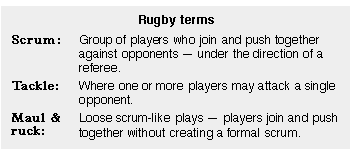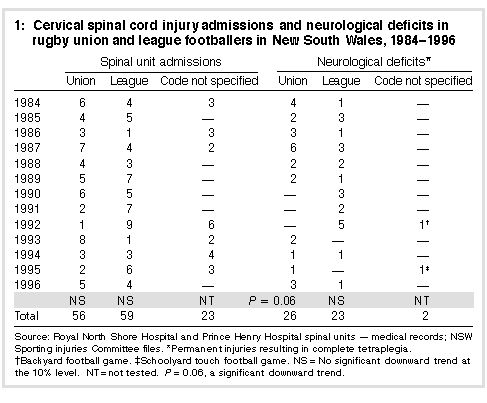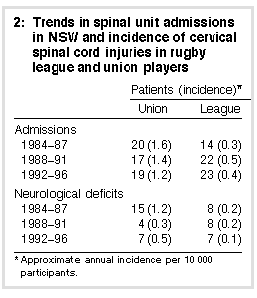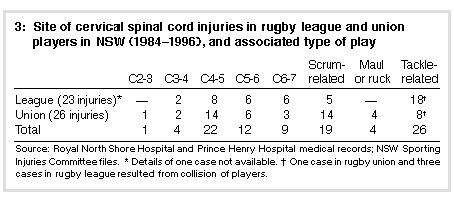Severe cervical spinal cord injuries related to rugby union and league football in New South Wales, 1984-1996
Tai R Rotem, James S Lawson, Stephen F Wilson, Stella Engel,
Sue B
Rutkowski and Chris W Aisbett
MJA 1998; 168: 379-381
For editorial comment see Yeo
Correction note: This article was published online with a typographic error that was corrected on 15 June 1998: A P value of 0.06 was misprinted as 0.6. Jump to corrected par.
Abstract -
Introduction -
Methods -
Results -
Discussion -
Acknowledgement -
References -
Authors' details
-
-
©MJA1998
Abstract |
Objective: To determine the frequency and
circumstances of serious cervical cord injuries associated with
rugby union and league football in New South Wales. Design: Retrospective review of patients with rugby football-related cervical spinal cord injuries. Setting: The two central spinal units in NSW, from January 1984 to July 1996. Outcome measures: Admission to spinal units; injury resulting in permanent tetraplegia. Results: During the review period, 115 rugby football players (56 union and 59 league) were admitted to the spinal units because of cervical spinal cord injuries. 49 patients had resultant permanent neurological deficits (complete tetraplegia [quadriplegia]) -- 26 associated with rugby union and 23 with rugby league. Two patients died of injury sequelae within two weeks of admission. There was no significant change in the rate of football-related admissions to spinal units for either code. There was a small decline in the number (from 15 in 1984 to 1987 to 7 in 1992 to 1996) and incidence (from 1.2 to 0.5 per 10 000 participants) of patients with tetraplegia associated with rugby union. When this decline was tested as a trend over the years, it was found to be statistically significant (P = 0.06). No significant trend was found in the tetraplegia data associated with rugby league. Cervical spinal cord injuries leading to complete tetraplegia were most commonly associated with scrum-like plays in union and with tackles in league. Conclusion: Serious cervical spinal injuries associated with both codes of rugby continue to occur in NSW. Rugby football in its various forms is still an inherently dangerous game. |
Introduction |
Injury to the cervical spinal cord sustained while playing rugby
union or league football has tragic personal consequences, with
subsequent high demands on community resources.1 During the 1970s and early 1980s
there was an approximately twofold increase in the incidence of such
injuries in many countries,2-4
possibly because of the development of more powerful scrums
and tackles (see Box for terms). In response, between 1984 and 1996,
new rules were introduced intermittently, existing rules
were more strictly enforced, and "safety" programs were offered --
these included exercises for strengthening players' neck muscles
and the banning of players with long thin necks from taking dangerous
positions, such as the front row of scrums.
We report the findings of a survey of rugby union- and league-related cervical spinal cord injuries in New South Wales (NSW) for the period 1984 to 1996.
|
Methods |
We retrospectively reviewed the medical records of all patients
admitted to the two central spinal units in NSW (at the Royal North
Shore Hospital and Prince Henry Hospital, Sydney) because of
cervical spinal cord injuries associated with rugby union and rugby
league football from January 1984 to December 1996. Patients
transferred from outside NSW were excluded from the analysis. Almost
all patients (more than 95%) with spinal injuries that occur
in NSW are admitted to these two units.
Additional information about the circumstances of the injuries, including eyewitness reports of the events leading to them, was obtained from the NSW Sporting Injuries Committee -- a statutory authority which administers an insurance scheme for people permanently injured while playing sports. We also estimated the number of participants in rugby union and league football in NSW per year in the review period, based on the Committee's data5 plus surveys of NSW schoolboy football participants.6 As some of these data were incomplete and there was some duplication, these estimates are broad approximations only. Statistical analysisThe number of cervical spinal cord injury cases is small, so any statistical analysis necessarily lacks power. To develop valid conclusions from this study, we analysed cases of cervical spinal cord injuries according to:
When there are large numbers of participants and the risk of cervical spinal cord injury to any particular player is very low over a short time period -- and the injury is permanent and will not allow a return to the game -- the number of injuries in each year is assumed to follow a Poisson distribution. In the absence of data on hours of playing football or training for football, we assumed that the total number of hours devoted to the game for each code and grade did not vary from year to year. The null hypothesis for each test we performed was that there was no change in aggregated risk of cervical spinal injury against the alternative that the risk had decreased. All tests were based on the null-hypothesis assumption that the best estimate of annual rate of injuries was the average rate of injuries. We then fitted a simple linear regression, of time, to a probability transformation of the injury data. The number of injuries for each year was converted to the probability of observing, at most, that number of injuries in a particular year. These values were then converted to their corresponding standard normal score. The tests were based only on the regression slopes, which were tested to see if they were negative. The critical level of significance for these tests was 0.1. All calculations were performed using Microsoft Excel. The function POISSON was used to calculate the cumulative probabilities; the function NORMINV was used to calculate the standard normal scores; the function LINEST was used to calculate the slope and its standard error; and the function TDIST (one-tailed 11 degrees of freedom) was used to obtain the significance of the results. The Random Number Generator was used in a small simulation study to confirm the size of the testing procedure. |
Results |
During the 13-year period of the review, 117 rugby football players
(56 union and 59 league players, plus one "backyard" and one "touch"
player) were admitted to the spinal units because of cervical spinal
cord injuries. The injuries were associated with permanent
neurological deficits which led to complete tetraplegia
(quadriplegia) in 26 union and 23 league players and in both the
"backyard" and the "touch" football players. (The touch and backyard
football players were not included in this analysis because they were
not playing according to official union or league rules [Table 1].) The 23 "unspecified" admissions
shown in Table 1 could not be included in the
formal analysis because the football code was omitted from their
clinical records. Two patients died of pneumonia within 14 days of
sustaining the cervical spinal cord injuries.
The age range of the injured players from both codes was 15-37 years (median, 22 years); all were male. The number of patients admitted per year to the spinal units because of cervical spinal cord injuries varied widely: from one to nine per year for league and one to eight per year for union. The number of players who had permanent tetraplegia varied from none to five per year for league and none to six for union (Table 1). Incidence and trendsThere were about 106 000 participants in rugby league and about 31 000 in rugby union in NSW during each year of the review.5,6 Trends in rates of admissions and incidence of permanent neurological deficits per 10 000 participants are shown in Table 2.
Type of play associated with severe cervical spinal cord injuriesAlthough detailed self-reports and eyewitness accounts of the events surrounding the injuries were available for 43 of the 49 patients with complete tetraplegia, no consistent patterns of play or events could be identified other than that the injury occurred in scrum-like plays (scrums, mauls and rucks; n = 23) or tackles (n = 26). Repeatedly, eyewitnesses observed that a player was found paralysed on the ground, without an obvious causal explanation, while the general play moved on. This lack of a specific, out-of-the-ordinary event was supported by two video recordings of cervical spinal cord injuries that occurred during scrums. The injuries were most common in scrum-like plays in union and in tackles in league. The most common level of spinal cord damage was C4-5 (Table 3). |
Discussion |
Despite its limitations as a retrospective study (such as the use of
records created for other purposes), the findings of this review are
disturbing. While for union players there was a small reduction in
both the number and incidence of those with permanent neurological
deficits leading to tetraplegia, there were no such changes for
league players. Nor were there any changes for either code in the
number of players admitted or rates of admission to spinal
units.
While any fall in the number and incidence of permanent neurological deficits among union players is pleasing and may well be a consequence of rule changes and safety measures,7 the unchanged rate of admissions to spinal units suggests that such improvements may not be sustained. In those players admitted to spinal units who do not experience permanent neurological deficits, the injuries can be regarded as "near misses" (ie, possible damage to the vertebral column without spinal cord injury).7 While evacuation procedures for suspected cervical and other spinal cord injuries may vary, such "near misses" included in the admission rates offer a useful indicator of the risks of such injuries associated with rugby union and league football.8 Our observation that cervical spinal cord injuries are more common in scrum-like plays in union and tackles in league is similar to recent findings in New Zealand.7 However, there is insufficient information in this review and in the New Zealand7 and other reviews9 of rugby football-associated spinal cord injury upon which to base sound recommendations for detailed changes to the rules or other safety measures. These reviews confirm the obvious -- that both rugby union and league are inherently dangerous games. There appear to be several options:
|
Acknowledgement | This study was conducted with a grant from the NSW Sporting Injuries Committee. Disclaimer of conflict of interest: Apart from providing access to their own case files, the NSW Sporting Injuries Committee was in no way involved with the collection or analysis of data and did not have the right to disapprove or influence the contents of the manuscript. |
References |
(Received 18 Sep 1997, accepted 27 Jan 1998) |
Authors' details
School of Health Services Management, Faculty of Medicine, University of NSW, Sydney, NSW.Tai R Rotem, BSocSci, Research Fellow;
James S Lawson, MD, MHA, Professor;
Chris W Aisbett, BSc, Visiting Fellow.
Department of Aged Care and Rehabilitation, Royal North Shore
Hospital, Sydney, NSW.
Stephen F Wilson, MB BS, FAFRM(RACP), Senior Staff Specialist.
Department of Rehabilitation, Prince Henry Hospital, Sydney, NSW.
Stella Engel, DPRM, FAFRM(RACP), Director.
Spinal Injuries Unit, Royal North Shore Hospital, Sydney, NSW.
Sue B Rutkowski, MB BS, Director.
Reprints will not be available from the authors.
Correspondence:
Professor J S Lawson, School of Health Services Management, Faculty
of Medicine, University of NSW, Sydney, NSW 2052.
-
Readers may print a single copy for personal use. No further reproduction or distribution of the articles should proceed without the permission of the publisher. For permission, contact the Australasian Medical Publishing Company
Journalists are welcome to write news stories based on what they read here, but should acknowledge their source as "an article published on the Internet by The Medical Journal of Australia <http://www.mja.com.au>".
<URL: http://www.mja.com.au/>
Received 21 December 2025, accepted 21 December 2025
- Tai R Rotem
- James S Lawson
- Stephen F Wilson
- Stella Engel
- Sue B Rutkowski
- Chris W Aisbett








